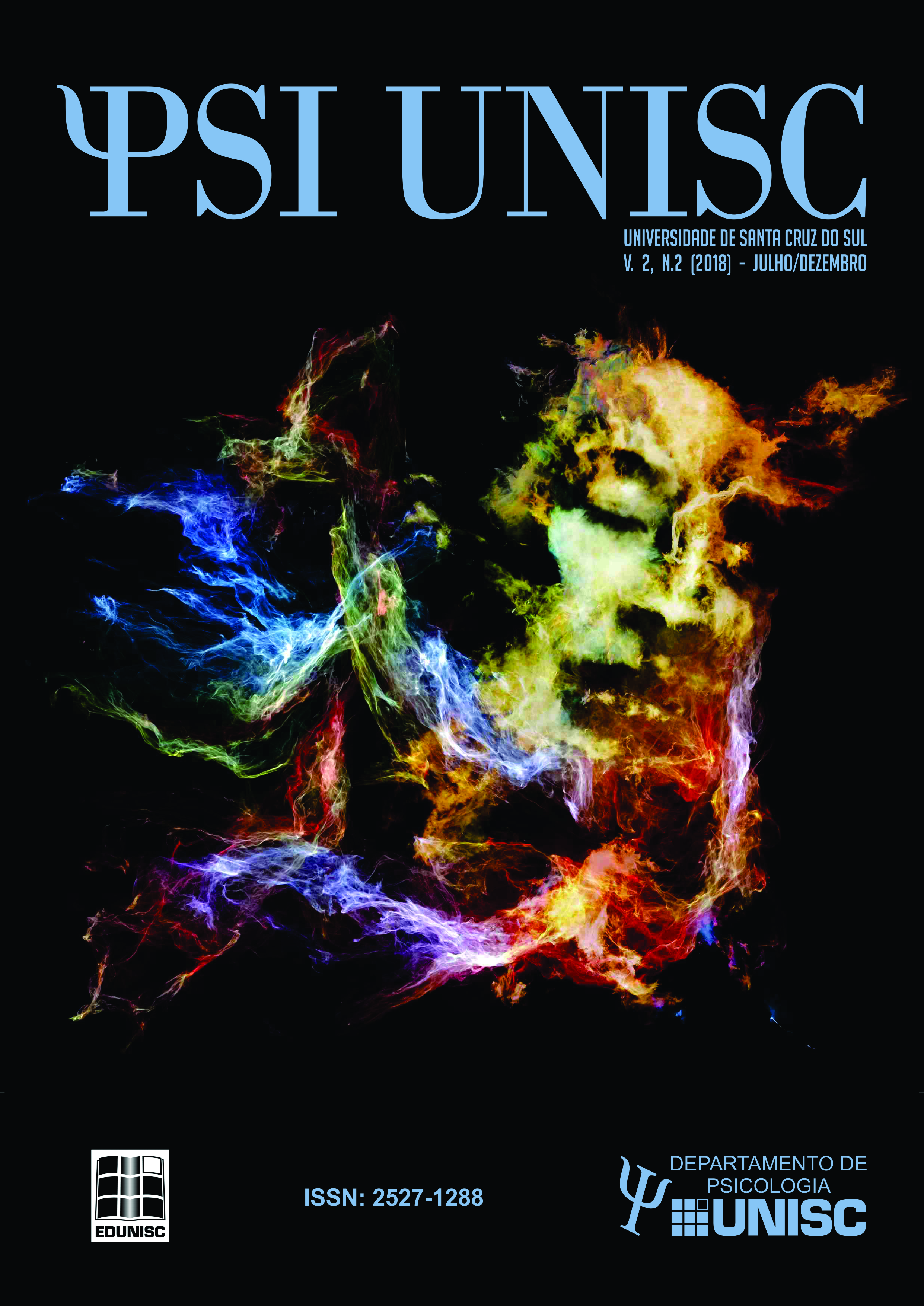Idosos LGBT que Vivem em Instituições de Cuidados: Desafios e Barreiras para a Manutenção dos Direitos Sexuais
DOI:
https://doi.org/10.17058/psiunisc.v2i2.12088Palavras-chave:
Direitos Sexuais, lares para pessoas idosas, as pessoas LGBT, atitudes.Resumo
O direito à liberdade de expressão da identidade sexual e orientação de pessoas idosas que vivem em contextos institucionais é submetido a uma série de desafios específicos, que colocá-o em risco. O objetivo deste artigo é identificar e refletir sobre esses desafios e, refletir sobre as medidas para diminui-los ou eliminá-los. Ele descreve o contexto da violência sexual, o estigma associado com o grupo LGTB, e como este pode ser exacerbado entre os idosos. E, em seguida, discute os medos e expectativas das comunidades LGBT no que diz respeito a cuidados institucionais, bem como atitudes para com os membros deste grupo por parte de profissionais e residentes heterossexuais. Por último, várias propostas para garantir os direitos sexuais das pessoas LGBT que vivem em instituições.
Downloads
Referências
Adamczyk, A., & Pitt, C. (2009). Shaping attitudes about homosexuality: The role of religion and cultural context. Social Science Research, 38(2), 338-351.
Ahrendt, A., Sprankle, E., Kuka, A., & McPherson, K. (2017). Staff member reactions to same-gender, resident-to-resident sexual behavior within Long-Term Care Facilities. Journal of Homosexuality, 64, 1502-1518.
Barbara, A.M., Quandt, S.A., & Anderson, R.T. (2001). Experiences of lesbians in the health care environment. Women & Health, 34(1), 45-62.
Bauer, M., Featherstonhaugh, D., Tarzia, L., Nay, R., Wellman, D. & Beattie, E. (2013). ‘I always look under the bed for a man’. Needs and barriers to the expression of sexuality in residential aged care: the views of residents with and without dementia. Psychology and Sexuality, 4(3), 296–309.
Bybee, J. A., Sullivan, E. L., Zielonka, E., & Moes, E. (2009). Are gay men in worse mental health than heterosexual men? The role of age, shame and guilt, and coming-out. Journal of Adult Development, 16(3), 144-154.
Beals, K. P., Peplau, L. A., & Gable, S. L. (2009). Stigma management and well-being: The role of perceived social support, emotional processing, and suppression. Personality and Social Psychology Bulletin, 35(7), 867-879.
Beehler, G. P. (2001). Confronting the culture of medicine: Gay men’s experiences with primary care physicians. Journal of the Gay and Lesbian Medical Association, 5(4), 135-141.
Bell, S. A., Bern-Klug, M., Kramer, K. W., & Saunders, J. B. (2010). Most nursing home social service directors lack training in working with lesbian, gay, and bisexual residents. Social Work in Health Care, 49(9), 814-831.
Brotman, S., Ryan, B., y Cormier, R. (2003). The health and social service needs of gay and lesbian elders and their families in Canada. The Gerontologist, 43(2), 192-202.
Calasanti, T., & Kielcot, K. (2012). Intersectionality and aging families. In R. Blieszner, & V. Bedford (Eds.), Handbook of Families and Aging (pp. 398–434). Santa Barbara, CA: Praeger.
Carroll, A. (2016). State-sponsored homophobia: A world survey of sexual orientation laws: criminalisation, protection and recognition. Geneva: International Lesbian, Gay, Bisexual, Trans and Intersex Association (ILGA).
Chatterjee, S. (2014). Problems faced by LGBT people in the mainstream society: Some recommendations. International Journal of Interdisciplinary and Multidisciplinary Studies, 1(5), 317-331.
Claes, J. A., & Moore, W. (2000). Issues confronting lesbian and gay elders: The challenge for health and human services providers. Journal of Health and Human Services Administration, 23(2), 181-202.
Cohen, H. L., Curry, L. C., Jenkins, D., Walker, C. A., & Hogstel, M. O. (2008). Older lesbians and gay men: Long-term care issues. Annals of Long Term Care, 16(2), 33.
Dhamoon, R.K. (2011). Considerations on mainstreaming intersectionality. Political Research Quarterly, 64, 230-243. doi: 10.1177/1065912910379227
Doll, G. M. (2013). Sexuality in nursing homes: Practice and policy. Journal of Gerontological Nursing, 39(7), 30-37.
Donaldson, W. V., & Vacha-Haase, T. (2016). Exploring staff clinical knowledge and practice with LGBT residents in long-term care: A grounded theory of cultural competency and training needs. Clinical Gerontologist, 39(5), 389-409.
Dorsen, C. (2012). An integrative review of nurse attitudes towards lesbian, gay, bisexual, and transgender patients. Canadian Journal of Nursing Research, 44(3), 18–43.
Eliason, M. J. (1996). Caring for the lesbian, gay, or bisexual patient: Issues for critical care nurses. Critical Care Nursing Quarterly,19(1), 65-72.
Gilmer, M. J., Meyer, A., Davidson, J., & Koziol-McLain, J. (2010). Staff beliefs about sexuality in aged residential care. Nursing Praxis in New Zealand, 26(3), 17–24.
Grant, J. M. (2000). Outing age: Public policy issues affecting lesbian, gay, bisexual and transgender elders. Wahington, DC: The National Gay and Lesbian Task Force Policy Institute.
Hayward, L. E., Robertson, N., & Knight, C. (2013). Inappropriate sexual behaviour and dementia: An exploration of staff experiences. Dementia, 12(4), 463-480.
Herek, G.M. (2009). Sexual stigma and sexual prejudice in the United States: a conceptual framework. In D.A. Hope (Ed.), Contemporary Perspectives on Lesbian,Gay and Bisexual Identities: The 54thNebraska Symposium on Motivation (pp. 65–111). New York: Springer
Hillman, J. (2017). The sexuality and sexual health of LGBT elders. Annual Review of Gerontology and Geriatrics, 37, 13-26.
Hinrichs, K. L. M., & Vacha-Haase, T. (2010). Staff perceptions of same-gender sexual contacts in long-term care facilities. Journal of Homosexuality, 57(6), 776-789.
Hubbard, G., Tester, S. & Downs, M. (2003). Meaningful social interactions between older people in institutional care settings. Ageing & Society, 23(1), 99-114.
Hughes, A. K., Harold, R. D., & Boyer, J. M. (2011). Awareness of LGBT aging issues among aging services network providers. Journal of Gerontological Social Work, 54(7), 659-677.
Inglehart, R.F., Ponarin, E., & Inglehart, R. C. (2017). Cultural change, slow and fast: The distinctive trajectory of norms governing gender equality and sexual orientation. Social Forces, 95(4), 1313-1340.
Johnson, M. J., Jackson, N. C., Arnette, J. K., & Koffman, S. D. (2005). Gay and lesbian perceptions of discrimination in retirement care facilities. Journal of Homosexuality, 49(2), 83-102.
Kontos, P., Grigorovich, A., Kontos, A. P., & Miller, K. L. (2016). Citizenship, human rights, and dementia: Towards a new embodied relational ethic of sexuality. Dementia, 15(3), 315-329.
Lester, P.E., Kohen, I., Stefanacci, R.G., & Feuerman, M. (2016). Sex in nursing homes: A survey of nursing home policies governing sexual activity. Journal of the American Medical Directors Association, 17(1), 71-74.
Lichtenberg, P. A. (2014). Sexuality and physical intimacy in long-term care. Occupational Therapy in Health Care, 28(1), 42-50.
Lyons, I. (2009). Public perceptions of older people and ageing: A literature review. Dublin: National Centre for the Protection of Older People. Retrieved from http://www.ncpop.ie/userfiles/file/ncpop%20reports/Review%201%20LR%20Older%20people%20and%20ageing.pdf
McFarland, P. L., & Sanders, S. (2003). A pilot study about the needs of older gays and lesbians. Journal of Gerontological Social Work, 40(3), 67-80.
McIntosh, D. (1981). Sexual attitudes in a group of older women. Issues in Mental Health Nursing, 3(1-2), 109-122.
Morgan, L.A. (2009). Balancing safety and privacy: the case of room locks in assisted living. Journal of Housing for the Elderly, 23(3), 185–203.
Nelson, T.D. (2002). Ageism. Stereoryping and prejudice against older persons. Cambridge, MA: The MIT Press.
Neville, S. J., Adams, J., Bellamy, G., Boyd, M., & George, N. (2015). Perceptions towards lesbian, gay and bisexual people in residential care facilities: A qualitative study. International Journal of Older People Nursing, 10(1), 73-81.
Nieto, J. A. (1995). La sexualidad de las personas mayores en España. Madrid: Ministerio de Asuntos Sociales.
Porter, K. E., & Krinsky, L. (2014). Do LGBT aging trainings effectuate positive change in mainstream elder service providers? Journal of Homosexuality, 61(1), 197-216.
Quam, J. K., & Whitford, G. S. (1992). Adaptation and age-related expectations of older gay and lesbian adults. The Gerontologist, 32(3), 367-374.
Rodríguez-Díaz, C.E., Martínez-Vélez, J.J., Jovet-Toledo, G.G., Vélez-Vega, C.M., Hernández-Otero, N.O., Escotto-Morales, B.M., & Mulinelli-Rodríguez, J.J. (2016). Challenges for the well-being of and health equity of gay, lesbian, bisexual and trans people in Puerto Rico. International Journal of Sexual Health, 28(4), 286-295.
Schwinn, S., & Dinkel, S. (2015). Changing the culture of long-term care: Combating heterosexism. OJIN: The Online Journal of Issues in Nursing, 20(2).
Stein, G. L., Beckerman, N. L., & Sherman, P. A. (2010). Lesbian and gay elders and long-term care: Identifying the unique psychosocial perspectives and challenges. Journal of Gerontological Social Work, 53(5), 421-435.
Van den Akker, H., van der Ploeg, R. & Scheepers, P. (2013). Disapproval of homosexuality: Comparative research on individual and national determinants of disapproval of homosexuality in 20 European countries. International Journal of Public Opinion Research, 25, 64-86. doi:10.1093/ijpor/edr058
Van der Star, A., & Bränström, R. (2015). Acceptance of sexual minorities, discrimination, social capital and health and well-being: a cross-European study among members of same-sex and opposite-sex couples. BMC Public Health, 15, 812. doi: 10.1186/s12889-015-2148-9.
Veenstra, G. (2011). Race, gender, class, and sexual orientation: intersecting axes of inequality and self-rated health in Canada. International Journal for Equity in Health, 10, 1-11. doi: 10.1186/1475-9276-10-3
Villar, F., Celdrán, M., Fabà, J., & Serrat, R. (2014). Barriers to sexual expression in residential aged care facilities: Comparison of staff and residents’ views. Journal of Advanced Nursing, 70(11), 2518-2527.
Villar, F., Celdrán, M., Serrat, R., Fabà, J., & Martínez, T. (2017). Sexualidad en entornos residenciales de personas mayores. Madrid: Fundación Pilares. Recuperado el 8 de julio de 2018 de http://www.fundacionpilares.org/docs/publicaciones/fpilares-guia03-guia-sexualidad-2017.pdf
Villar, F., Serrat, R., Fabà, J., & Celdrán, M. (2015a). As long as they keep away from me: Attitudes toward non-heterosexual sexual orientation among residents living in Spanish residential aged care facilities (RACFs). The Gerontologist, 55(6), 1006-1014.
Villar, F., Serrat, R., Fabà, J., & Celdrán, M. (2015b). Professionals’ reactions towards lesbian, gay or bisexual (LGB) people living in residential aged care facilities (RACFs) who actively disclose their sexual orientation. Journal of Homosexuality, 62(8), 1126-1143.
Walker, B. L., Osgood, N. J., Richardson, J. P., & Ephross, P. H. (1998). Staff and elderly knowledge and attitudes toward elderly sexuality. Educational Gerontology, 24(5), 471-489.
Zeidenstein, L. (1990). Gynecological and childbearing needs of lesbians. Journal of Nurse Midwifery, 35(1), 10-18.
Downloads
Publicado
Como Citar
Edição
Seção
Licença
A submissão de originais para este periódico implica na transferência, pelos autores, dos direitos de publicação impressa e digital. Os direitos autorais para os artigos publicados são do autor, com direitos do periódico sobre a primeira publicação. Os autores somente poderão utilizar os mesmos resultados em outras publicações indicando claramente este periódico como o meio da publicação original. Em virtude de sermos um periódico de acesso aberto, permite-se o uso gratuito dos artigos em aplicações educacionais e científicas desde que citada a fonte conforme a licença CC-BY da Creative Commons.




